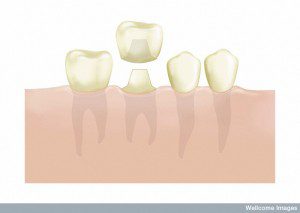 Sometimes covering up a problem isn’t going to solve it. With dental crowns, however, this isn’t the case. Crowns are used to protect, restore, and support broken or weakened teeth. For those who have severely discolored or sharp, malformed teeth, crowns can also be used to cover the teeth. They may be used to cover a bridge or large filling as well. Crowns are like protective hats that, in addition, help prevent further damage to the tooth. At my Beverly Hills practice, I offer state-of-the-art crown fixtures to help protect your teeth and get you back to looking and feeling your best.
Sometimes covering up a problem isn’t going to solve it. With dental crowns, however, this isn’t the case. Crowns are used to protect, restore, and support broken or weakened teeth. For those who have severely discolored or sharp, malformed teeth, crowns can also be used to cover the teeth. They may be used to cover a bridge or large filling as well. Crowns are like protective hats that, in addition, help prevent further damage to the tooth. At my Beverly Hills practice, I offer state-of-the-art crown fixtures to help protect your teeth and get you back to looking and feeling your best.
Permanent crowns may be made of metal, porcelain, all-resin, or ceramic. Metals used in crowns include gold, palladium, or base-metals. With metal crowns, less tooth structure has to be removed when fitting. Also, in comparison to other crowns, metals usually last longer with normal wear and tear such as biting and chewing. However because they are metallic in color, many patients prefer porcelain for greater discretion; porcelain crowns are color-matched to the patient’s surrounding teeth, so it appears like a real tooth. The porcelain and ceramic fixtures are best for front teeth, due to appearing authentic, usually suiting patients who have metal allergies best. All-resin crowns are less expensive, but also more prone to chipping and fractures.
Placing a crown on the tooth is a delicate procedure. The tooth is first numbed to reduce any pain, and then filed down on top and the sides of the tooth in order to fit the crown. If the tooth is cracked or broken, I may build the broken areas with filling material. Once the tooth is reshaped, an impression paste will be placed on the tooth where the crown will be set. I will ensure that the crown fits well and doesn’t affect your bite. The impressions are then sent to a dental lab for the crown to be made. A temporary crown will generally be placed until your permanent is made.
It generally takes about two to three weeks for a crown to be manufactured. On your second visit, the temporary crown will be removed and your permanent crown will be fitted into place. If it fits right, I will numb your tooth with an anesthetic and permanently cement the crown into place.
If you are interested in learning more about dental crowns, which are commonly performed in conjunction with dental implants, please visit my Beverly Hills office. I will help you get the most dazzling, healthy-looking smile possible!